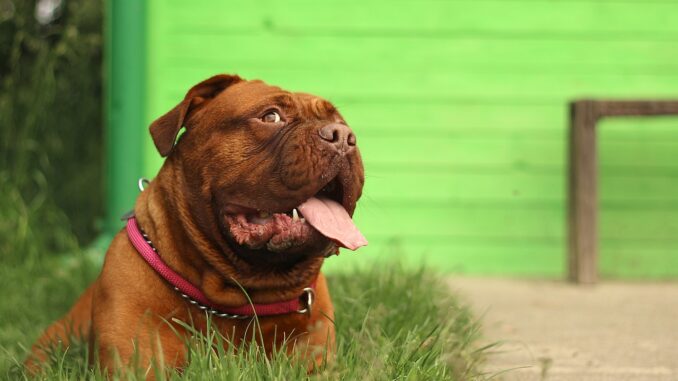
[ad_1]
The Mastiff, often referred to as the gentle giant of the canine world, exudes an impressive and formidable appearance. With their immense size, strong build, and historical role as guardians, the question often arises: Are Mastiffs aggressive? Let’s delve deep into understanding the temperament of Mastiffs, the influence of training and environment, and debunk some myths surrounding this noble breed.
Mastiffs: A Historical Overview
Mastiffs have a long history that traces back to ancient civilizations. Often depicted in art and literature, these dogs were utilized for war, hunting, and guarding due to their strength and loyalty. Despite their intimidating presence, Mastiffs were selectively bred to be protective without unnecessary aggression. This distinction is essential in understanding the innate temperament of the breed.
The Natural Temperament of Mastiffs
Contrary to popular belief, Mastiffs are inherently gentle, affectionate, and loyal creatures. They form strong bonds with their families and are especially patient with children. While they might display an aloof demeanor towards strangers, Mastiffs are more likely to be wary rather than aggressive. Their sheer size often means they don’t need to resort to overt aggression; their presence alone can be enough of a deterrent.
Training: The Key to a Well-Behaved Mastiff
Training plays a pivotal role in shaping any dog’s behavior, and Mastiffs are no exception. Given their size, it’s essential to start training at an early age.
- Socialization: Exposing Mastiffs to various environments, sounds, people, and other animals during their formative months lays the foundation for a well-adjusted adult dog.
- Positive Reinforcement: Mastiffs respond best to positive reinforcement techniques. Their sensitive nature means they don’t respond well to harsh correction.
- Consistency: Consistency in training helps Mastiffs understand what’s expected of them, fostering a sense of security and reducing potential behavioral problems.
The Impact of Environment on Mastiffs’ Behavior
The environment in which a Mastiff is raised and lives has a significant influence on its behavior.
- Stressful Environments: A chaotic or constantly changing environment can lead to anxiety in Mastiffs. An anxious Mastiff can sometimes become unpredictable or defensive.
- Space: Given their size, Mastiffs require space. Cramped living conditions can lead to frustration and pent-up energy, which might manifest as destructive behavior.
- Interaction: Mastiffs thrive on human interaction and can become depressed or agitated if left alone for extended periods.
Addressing Aggression Myths Around Mastiffs
Several myths label Mastiffs as aggressive, most of which stem from misinterpreted behaviors or isolated incidents. It’s crucial to differentiate between protective instincts and unwarranted aggression. A Mastiff that’s barking at a stranger at the door is displaying its protective nature, not necessarily aggressive behavior.
Adopting Mastiffs: What to Expect
Many Mastiffs find their way into rescue organizations or shelters. Adopting a Mastiff can be a rewarding experience. These dogs, when given a second chance in a loving home, often display immense gratitude and loyalty. Rescued Mastiffs might come with some prior training, and most shelters conduct temperament tests, providing potential adopters with insights into the dog’s behavior.
Conclusion
While Mastiffs are imposing in stature, labeling them as aggressive is a gross misrepresentation of their true nature. With proper training, a stable environment, and love, Mastiffs prove to be gentle, loyal companions suitable for families. It’s essential to approach this breed with understanding, respect, and knowledge to foster a harmonious relationship.
Frequently Asked Questions About Mastiffs & Aggression

1. Are Mastiffs naturally aggressive dogs?
Mastiffs are not inherently aggressive. While they have a history of being guardians and protectors, they have been selectively bred to be protective without being unnecessarily aggressive. Their natural temperament leans more towards being gentle, loyal, and affectionate with their families.
2. How does early training impact the behavior of Mastiffs?
Early training, especially during a Mastiff’s formative months, is crucial. Proper training and socialization can help them become well-adjusted adult dogs, reducing the chances of unwarranted aggressive behaviors. Consistent training using positive reinforcement techniques works best for this breed.
3. Do Mastiffs get more aggressive as they age?
Mastiffs, like all dogs, may exhibit behavioral changes as they age due to factors like health issues or diminished sensory abilities. It’s not that they become more aggressive, but they might become more irritable or sensitive. Regular vet check-ups and understanding their changing needs are essential.
4. How can I ensure my Mastiff doesn’t become territorial or aggressive towards strangers?
Socializing your Mastiff from a young age and exposing them to different environments, people, and animals can prevent unwarranted territorial behavior. Positive encounters with strangers, both in and out of the home, can teach them to be more accepting and less wary.
5. Does the living environment influence a Mastiff’s aggression levels?
Yes, the environment plays a significant role in shaping a Mastiff’s behavior. Stressful or cramped living conditions can lead to frustration or anxiety in Mastiffs. They thrive on interaction, so a balanced environment with space, play, and human companionship reduces the chances of aggressive behaviors.
6. Are male Mastiffs more aggressive than females?
Gender alone doesn’t dictate a Mastiff’s aggression levels. However, unneutered males might display more territorial or dominant behaviors. It’s essential to understand that individual temperament, training, and environment play a more significant role than gender in determining behavior.
7. What are the signs of aggression in Mastiffs, and how can they be addressed?
Signs of aggression include growling, snapping, raised hackles, and baring teeth. If a Mastiff displays such behaviors, it’s essential to consult with a professional dog trainer or behaviorist. Addressing the root cause, be it health-related, environmental, or behavioral, is crucial.
8. How do Mastiffs usually react to other dogs?
While many Mastiffs coexist peacefully with other pets, their reactions can vary based on their training, socialization, and individual temperament. Early socialization with other dogs can help in promoting positive interactions.
9. Are rescue or shelter Mastiffs more prone to aggression?
Not necessarily. Many Mastiffs in shelters are there due to circumstances beyond their control, not because of aggression. In fact, adopting from a rescue or shelter often comes with the benefit of insights into the dog’s behavior, as most conduct temperament tests. Rescued Mastiffs, when given love and stability, often prove to be loyal and gentle companions.
10. What benefits come with adopting a Mastiff from a rescue or shelter?
Adopting a Mastiff from a rescue or shelter offers the dog a second chance at a loving home. These dogs often display immense gratitude and loyalty to their new families. Additionally, many rescued Mastiffs come with prior training, and adopters can gain insights into their temperament and behavior from the shelter staff.
[ad_2]
Source link

Leave a Reply